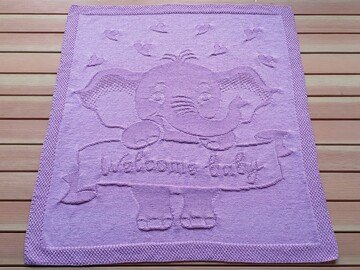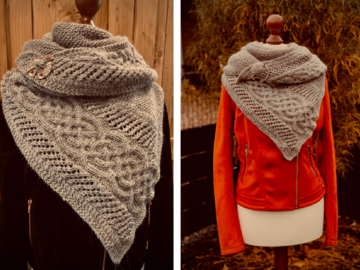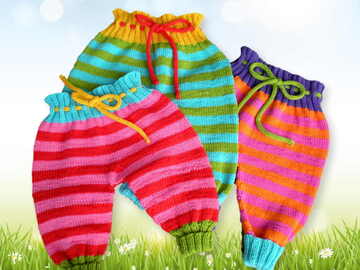.jpg)
You can work this square with the “B” either in classic double sided knitting, i.e. correct on one side, mirrored on the other. Or you choose the advanced version, the non-mirrored double sided knitting – then you will get the “B” show correctly on both sides. How this works I will explain for you in detail. The pattern for the letter “A” (which is easier to knit as it is symmetrical and will show correctly on both sides) you will find in this blog entry:
https://www.crazypatterns.net/en/blog/3852/free-double-knitting-pattern-for-an-a
If you go for the classic version, you can scroll down to the according knitting chart. Whereas if you choose the advanced version, please read the explanation for the non-mirrored double sided knitting first.
Material used:
- Cotton, e.g. Schachenmayr Catania (125 m / 50 gr), two different colours (one light, one dark), I used blue and apricot; approx. 10 gr each (of course you can use any other / similar yarn)
- Circular needles 2.5 mm
- Additional circular needle 2.5 mm (alternatively 2.0 mm or 3.0 mm) for bind off
- Darning needle, scissors
Gauge (double knitted with both colours):
22 sts x 34 rows = 10 x 10 cm
Size of the finished coaster is approx. 10,5 cm x 10,5 cm
Please note: If you have a different gauge, the size of the finished product will be different, too. I for example have used a bulkier cotton yarn (75 m / 50 gr), which results in a square with approx. 14,5 x 14,5 cm and 15 gr per colour needed.
Non-mirrored double knitting
When using the classic double knitting technique, the motif is mirrored on the back side, which doesn’t matter if it is a normal image. But if you knit letters / words, you would like them to be readable from both sides. Therefore, both sides must be knitted differently.
In the knitting chart, both sides are shown overlaying. Please don’t get frightened by the knitting chart – at first sight it looks complicated, but it isn’t really, if you work stitch by stitch. You just need to concentrate for the sections that are concerned.
In the example the coaster / pad is made of blue and apricot. “Blue” is my dark colour, “apricot” is my light colour. Please define which of your colours is the light colour and which is the dark colour. This is important, so that you know with which colour to start and which colour is meant in the knitting chart.
Classic double knitting only has two options : « no motif » (= knit in main colour, purl in contrast colour) or « motif » (= knit in contrast colour, purl in main colour). Thus, front and back side show the same motif, just mirrored and with reverse colours on the back side.
The non-mirrored version offers the additional option, that the motif only shows on one side (so that you can knit the letter individually for both sides). Depending on the side you work at the moment, this means « knit AND purl in light colour » or « knit AND purl in dark colour ». So you work one pair of stitches in the same colour in order to show the motif either only on the front side or only on the back side.
Please read the knitting chart cell by cell, and work each pair of stitches deliberately, according to the colour information in the chart. After each row, you can control if the image shows correctly.
Tipp for correcting stitches you knitted with the wrong colour: If you should discover that you used the wrong colour for a stitch, you can either knit backwards. Or you can drop the stitch carefully up to the row where the wrong colour was used. Then you «knit» the stitch with the correct colour row by row with the help of a crochet hook. Repeat this for the second stitch of the concerned pair.
Let’s start!
Cast on 24 pairs of stitches (one pair of stitches = 1 knit in colour 1, 1 purl in colour 2) with the invisible cast on (if you are not sure how to do this, you will find helpful video tutorials on the internet). If you cast on rather loosely, I recommend to use the smaller circular needle 2.0 mm, only for cast on.
Of course, you can use any other cast on method suitable for double knitting that you are familiar with.
Please note: in Row 1, main colour must be your dark colour. If you use the invisible cast on, begin with your light colour, so after turning you will knit with the dark colour and purl with the light colour.
Row 1
Now switch to the circular needles 2.5 mm.
Knit into back all dark knits, purl normally all light purls.
Cross threads when working the first pair of stitches and the last pair of stitches, thus the two sides will be connected at the edges.
I will show you here again how I do the selvedge stitch for this square. This stitch not only makes a neat edge, it also keeps both sides together. The pictures are from the blog entry for the letter “A”.
Row 2 – Selvedge stitch
Work all knits in the light colour, all purls in the dark colour.
Do a nice selvedge stitch from row 2 on, always at the end of the row. It looks nice and it binds both sides together.
Last knit stitch (light colour): slip stitch purlwise, yarn back (both colours):
.jpg)
Last purl stitch (dark colour): slip stitch purlwise, yarn back (light colour) respectively yarn forward (dark colour):
.jpg)
Turn; the light yarn is front, the dark yarn is back.
.jpg)
Knit and purl as usual.
Knitting chart for the motif:
You will get two different versions:
Version a) = the letter “B” in classic double sided knitting, i.e. on one side, the letter shows correctly, on the other side, the letter shows mirrored. You can choose this version if the back side of your project isn’t visible (e.g. for a pillow case).
Version b) = the letter “B” in advanced / non-mirrored double sided knitting; i.e. the letter will show correctly on both sides.
You can knit version a) according to the knitting chart. The version b) will be explained in detail in the following paragraph.
Knitting chart version a) classic double sided knitting
.jpg)
Explanation (every cell = one pair of stitches):
White cell = knit in main colour, purl in contrast colour
Blue cell = knit in contrast colour, purl in main colour
Rows with odd numbers (1. and further): main colour = dark colour, contrast colour = light colour
Rows with even numbers (2. and further): main colour = light colour, contrast colour = dark colour
Knitting chart version b) non-mirrored double sided knitting
.jpg)
Explanation (every cell = one pair of stitches):
White cell = knit in main colour, purl in contrast colour
Blue cell = knit in contrast colour, purl in main colour
Pink cell = knit AND purl in light colour
Grey cell = knit AND purl in dark colour
Rows with odd numbers (1. and further): main colour = dark colour, contrast colour = light colour
Rows with even numbers (2. and further): main colour = light colour, contrast colour = dark colour
Tip: when double knitting in rows, main and contrast colour change with each row. Before you start each row, identify which is the main colour in this row and whether you work the chart from right to left or from left to right. For example, you can work all rows with odd numbers from right to left (in working direction), and all rows with even numbers from left to right (against working direction).
Detailed explanation for version c)
Rows 1-6
According to the knitting chart, the first six rows of the square „B” are worked uni (i.e. knit in the respective main colour, purl in the respective contrast colour).
Row 7
As row 7 is a row with an odd number (with the dark colour as main colour), we work the knitting chart from right to left.
7 x k dark, p light
1 x k AND p dark
8 x k light, p dark
1 x k AND p light
7 x k dark, p light (selvedge stitch at the end of the row)
Turn.
Row 8
The knitting chart is read from left to right, with the light colour as main colour.
7 x k light, p dark
10 x k dark, p light
7 x k light, p dark (selvedge stitch at the end of the row)
Turn.
Row 9
The knitting chart is read from right to left, with the dark colour as main colour.
7 x k dark, p light
10 x k light, p dark
7 x k dark, p light (selvedge stitch at the end of the row)
Turn.
Row 10
The knitting chart is read from left to right, with the light colour as main colour.
6 x k light, p dark
1 x k AND p dark
2 x k dark, p light
6 x k light, p dark
2 x k dark, p light
1 x k AND p light
6 x k light, p dark (selvedge stitch at the end of the row)
Turn.
Continue the motif according to the knitting chart till row 36. In row 36 you don’t need to do a selvedge stitch, just knit and purl the last pair of stitches.
Now it’s time to bind off. As it fits perfectly with the invisible cast on, I will show you the invisible bind off here.
Invisible bind off:
Cut the light colour. We continue binding off with the dark colour. Cut the dark yarn and leave a strand in the length of approx 4 x the width of the coaster / pad (about 40-50 cm).
Separate the stitches in the front (all knit stitches) and back (all purl stitches) on two circular needles (you will need the additional circular needle now):
Take the first knit stitch from the left to the right tip of the current needle (1st needle). Take the first purl stitch on the additional needle (2nd needle). The next knit stitch again goes from the left to the right tip of the 1st needle, and the next purl stitch goes to the 2nd needle. And so on, until all stitches are separated:
.jpg)
Put the long dark strand into the darning needle.
Stick the darning needle purl wise into the 1st stitch on the 1st needle and pull through. The stitch stays on the needle.
Stick the darning needle knit wise into the 1st stitch on the 2nd needle and pull through. This stitch also stays on the needle.
*Stick the darning needle knit wise into the 1st stitch on the 1st needle. Drop this stitch off the needle. Stick the darning needle purl wise into the 2nd stitch on the 1st needle and pull through, this stitch stays on the needle.
Stick darning needle purl wise into the 1st stitch on the 2nd needle, drop this stitch off the needle. Stick darning needle knit wise into the 2nd stitch on the 2nd needle and pull through, this stitch stays on the needle.*
Repeat *-* across. Pull the yarn continuously, but not too tight, so that the bind off will be stretchable.
.jpg)
Weave in all ends. Done 😊
.jpg)
.jpg)
Hopefully you enjoyed doing this little project. Did you try the non-mirrored version? If yes, I hope it worked out well for you. Now you can use the motif resp. the knitting chart for various things, not only as a coaster or cleaning pad. I’m curious to hear about your ideas and creations. In addition to the «classic» ideas such as blankets (e.g. baby blanket with the baby’s name, or a sofa blanket with a saying) or pillow cases you could maybe try a head band with a name, a wash cloth with the initials of a person, or place mats with the names for all family members (the other letters will follow). My daughter uses the letters for playing and is quite creative.
Important: When using the advanced knitting chart for your individual projects, please be aware that the rows with odd numbers always must have the dark colour as main colour, and make sure you read the knitting chart in the correct direction. If you line up several letters next to each other for your project, you cannot use the unmirrored version (as the order of the letters on the ‘back side’ would have to be the opposite; unless the name is a palindrome like ANNA or OTTO, in which case it works). However, you can arrange the letters, e.g. for a name on a blanket or cushion cover, one below the other, in which case you can also use the non-mirrored version.
Maybe you would like to write in the comments about your ideas and projects, or you would like to show a picture of your creation in the Crazypatterns photo gallery?
If you liked this little project, feel free to visit my shop – there you will find many double sided knitting patterns. If you follow my shop, you will always be informed when there are news 😊
Please feel free to ask questions either by direct message or as a comment here on the blog site.
Kind regards, Sonja




























































































































































